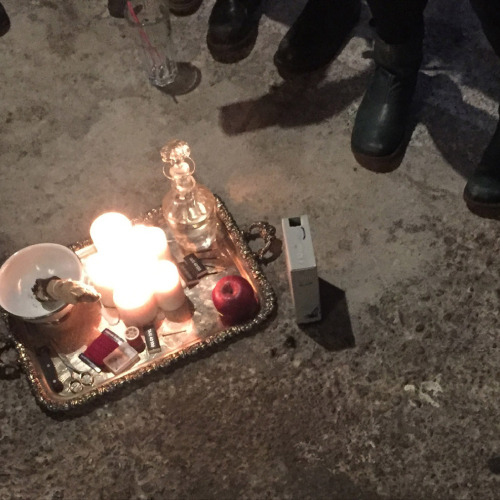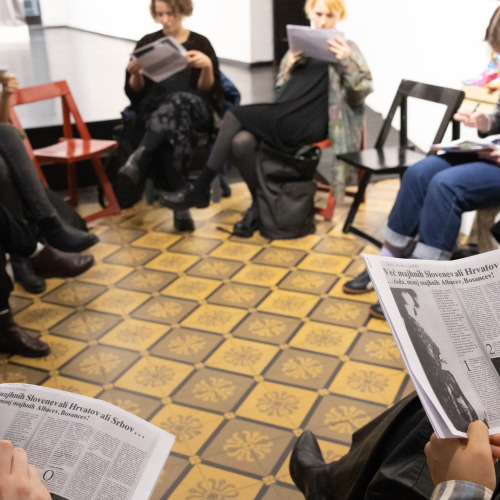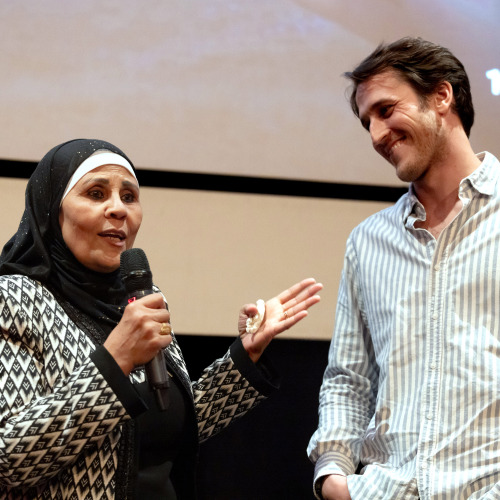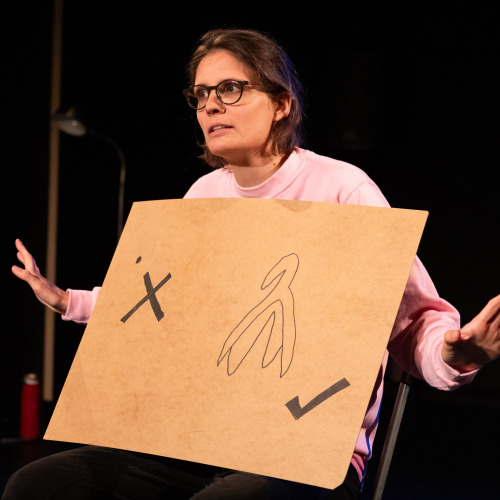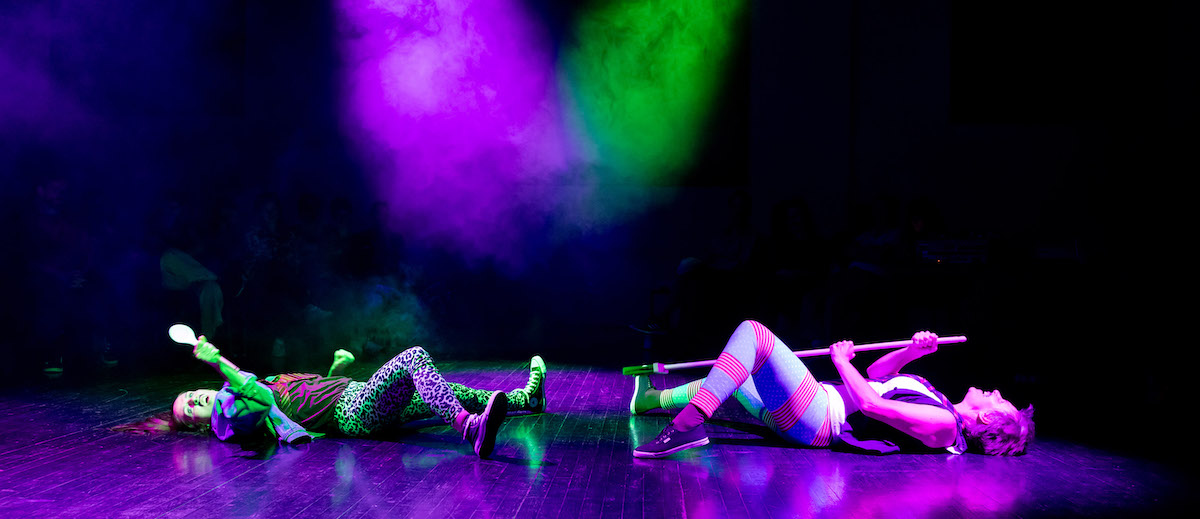
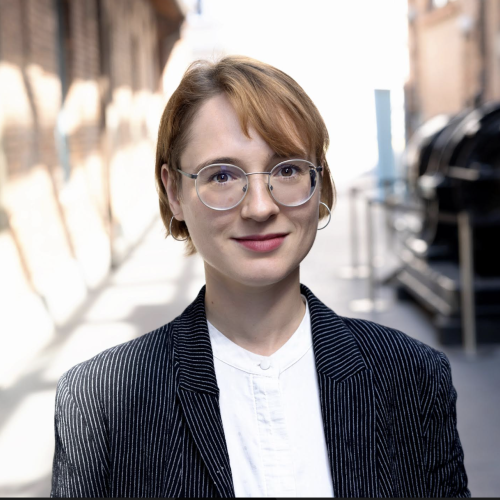
The Birth of the Artistic Creation Out of the Relationship
An interview with the artists Alenka Marinčič and Maja Dekleva Lapajne, who introduced themselves with the premiere of their new work On the Ground at the 29th City of Women Festival. We will have the opportunity to see it again at the Trigger festival at the end of March.
City of Women (COW): Alenka, Maja, you are both members of the Kolektiv Narobov. How did this collective come about, why and how did you connect?
Alenka: In 2004, the Kolektiv Narobov brought together six theatre creators (Gregor Moder, Sonja Vilč, Dražen Dragojević, Maja Dekleva Lapajne, Tomaž Lapajne Dekleva, Alenka Marinič) who had known each other for a long time and had collaborated in a wider improv community that had grown up in and around the KUD France Prešern. We were united by a common vision of improv theatre and theatre in general, and a desire to develop improvisation and to professionalize it. We soon became involved in the international improv community, where we still have strong connections today. In the beginning, we had a strong influence on each other, we learned from each other and developed together. As time went on, we started to develop in our own directions, and some of us no longer live in Slovenia. However, Maja and I have remained connected as co-creators.
COW: When and where did your desire to create theatre come from?
Alenka: I started doing theatre in high school. In fact, the first theatre workshop I took part in was the one Maja led with Vida Cerkvenik Bren. I was completely taken by this workshop - the feeling of creating something together with my fellow participants, of having my voice heard. The support and trust that is built up in the theatre space and that is necessary for a performance to run was so wonderful and new to me that I was completely absorbed by the theatre. I continued to do theatre while studying philosophy and history at the Faculty of Arts. In fact, I sometimes felt that I was doing theatre and studying a bit on the side. The aspects of performance practice that fascinated me at the time still inspire me today, and I think it is necessary to integrate them even more into the school and university system, or to create space for more such activities in schools. Just giving young people a place where they can meet and do something is a huge thing.
Maja: As a child in primary school, I had a terrible fear of public speaking. I was very shy and I remember feeling very uncomfortable when I ordered, let’s say, a loaf of bread in a shop. It may be that this anxiety had to do primarily with speaking, but also with the categories of what is appropriate and inappropriate in a particular social setting, and the physical inhibitions that follow from this. No wonder I am still most attracted to artistic improvisation, clowning and dance, because they are physical practices that work with what is (even if what is, is shyness), question conventions, break down categories and constantly expand the playing fields. Anyway, yes, similar to Alenka, I was “soaked” by the performing field in high school, through various clubs in ŠILA and Impro liga. It was while I was studying at the Faculty of Arts that I realised this was going to be my profession. It was important for me to combine my studies in the humanities with education in the performing arts, which I undertook mainly in Ljubljana, Seattle, Berlin and Vienna.
"Art helps us to reflect on our being and our experience of the world, and it teaches us to be different and accepting at the same time."
COW: Which artistic collectives and pedagogical approaches have influenced your work?
Alenka: Apart from improv theatre, I was very much influenced by the direction developed by the French pedagogue Jacques Lecoq. And of course, street theatre. I am very much attracted to and appreciate the engagements of the theatre of the oppressed, narrative theatre, cabaret and dance theatre.
Maja: Exploring artistic improvisation is a great source of inspiration. And physical theatre and clown theatre, which Alenka also mentioned. I would also add contemporary dance practices and working at the intersection of the artistic and the social. I am most influenced by the close collaborations I am part of. Alenka is a great influence and inspiration. And of course, all the people from Narobov and our common history. In the field of theatre improvisation there are Beatrix Brunschko, Randy Dixon, Roland Trescher, Rama Nicholas, Matthieu Loos, Sara Šoukal, the collectives Orcas Island Project and Mary Shelley’s Mothers, the Collective Impro and KD IGLU. In the field of dance and movement practice, I have been deeply inspired by collaborations with Andrea Podrzavnik and Dragana Alfirević. A very dear collaborator in the field of music is Hannu Risku. Many collaborations with Gregor Kamnikar, in the fields of dance, music, theatre, acting and clowning, have left a deep impression on me. I enjoy debating with Samo Oleami and find it important to explore contemporary clowning within the collective Za crknt. I appreciate production research approaches based on the work of Juš Milčinský, Gorilla Theatre, Theater im Bahnhof and City of Women. At the intersection of art and social action, collaborations with the collectives Red Noses, Kings of the Street and Hearing Voices are extremely important to me. Otherwise, the activities of all the people I have mentioned are broad and cannot be pinned down to one area, they are all somewhere in the field of exploratory artistic practices and life sustaining activities.
COW: You are both also involved in pedagogy. How important do you think it is to combine art and pedagogy, and why?
Alenka: For me, art is important in pedagogy and within the pedagogical process because it opens up new ways of thinking and being. It is often a harbinger of social change and new social currents because it responds to the current social situation. Art helps us to reflect on our being and our experience of the world, and it teaches us to be different and accepting at the same time. I know my position here is very subjective in terms of how I perceive art, but for me art gives me the tools to process life, and without these tools I cannot imagine how I would cope with the everyday and wider challenges of life. These are all aspects that I feel it is important to pass on to students, pupils and children. When I focus on theatre alone, it teaches us to work together, it gives us a space to express ourselves, to play through life in a joyful way, and all of these seem to me to be extremely important approaches.
Maja: Using artistic approaches in pedagogy develops creativity. Art creates new worlds, rediscovers new ways of living together. Imagining and creating new worlds is a necessity, especially at this point in the development of human society.
COW: How long have you been making art together, when and how did you connect?
Alenka: Maja and I have known each other for a long time and we have been creating together for just as long. With Underwater we consciously embarked on a long-term creative process, so from the very beginning we approached the performance as a work on a trilogy. We have had hours and hours of rehearsals and meetings, guest performances, late night writing sessions, growing closer and further apart, agreeing and disagreeing, and then hours and hours of rehearsals and meetings before and after rehearsals.
Maja: We have a long history of collaboration and co-creation, as well as a long history of close friendship, both for over 20 years. In a way we are each other’s home, one of our homes. It is true that we are closely connected, but not synchronously, closeness is the closeness of differences. Then there is our orientation, not to dwell on the familiar and not to reduce it to fixed categories, but at the same time not to seek the unknown all the time, but just to be, to co-create, to immerse ourselves in the familiar and the known with such strength and curiosity that in doing so we step into the unknown, expanding our relationship and the living work together.
It is not always easy, of course, but we take the joys, the incentives, the agreements, as well as the conflicts, the disagreements, the frustrations, the confusions, as precious doorways into relationship and work. We are not very prone to compromise and when we disagree or have different wishes and views, we take our time, we are patient with each other and we don’t run away from our work. If we were to compromise and each of us were to reduce and cut back our own wishes and proposals, there would be less and less of us in the work and in contact. We prefer to trust that a third possibility will probably emerge alongside one or the other. Or that a way will be found for two ideas to coexist gently. Or that one of us, in discussion and performance practice, will accept and be enthusiastic about the other’s proposal. Or that we will open up our disagreement as an interesting topic for work.
"Among influential female directors, internationally renowned educators, renowned artists, there are more men, who are often better paid and more visible."
COW: Underwater had its premiere at Pocket Theatre Studio in 2017. As an artist, how do you deal with the lack of public space to practice, and how do you feel about the gentrification of Ljubljana over the years?
Alenka: There is a huge lack of rehearsal and performance space in Ljubljana that would be more widely accessible to artists – it’s a process that’s been going on for about 20 years, and these cuts are felt keenly by independent artists. There are halls and performance spaces, but they are open to a relatively narrow range of creators. There is no space that is truly inclusive and able to accommodate many different groups and expressions under its roof. A lot of spaces are very specialized in certain genres, and if you don’t fit into that framework, it’s very difficult to get in. And if you do, it’s very difficult to afford the market rents as an independent artist. The closure of spaces like KUD and Rog, where it was possible for very different groups to coexist, is so deeply felt and has very big consequences for us and our work. That’s why we ended up at Pocket Teater Studio in 2017, because we just couldn’t get another space to perform. And working with Pascal, who runs the space, has been great because he’s also a bit of a maverick on the fringes of the independent scene. On the other hand, it has to be said that the arts in Slovenia are still relatively well supported - we have a self-employed status in culture, calls for proposals at national and local level. The fact that we are a very small country can also be a good thing in a way, because it is quite transparent, and if you do a good job, it shows up somewhere in the end.
COW: Performance On the Ground contains elements of music, circus, object theatre... How do you put together a script like this? What comes first, what is the dramaturgy of this process?
Maja: A key layer of the work is observing where we are, what’s going on in our lives, what are the pressing issues, what interests us, what makes us tick, what we’re passionate about, what we’re tired of, and to a large extent what’s between us. When we work with all that, we’re examining a lot of different approaches, different ways of performing, different entrances into the material. Rather than deciding in advance how we are going to approach things, we try to play the current themes and states with whatever is available to us at the moment - be it the concrete space we are working in, the objects that surround us, artistic approaches from the fields of improvisation, clowning, physical theatre, dance, music. Whatever it is already defines the coordinates of the playing field.
Crossing different approaches, we found in the process of Underwater that music was the most “triggering” for us, because we were dealing with the theme of how to still create, move, live within the oppressive constraints of capitalist relations. In music we were very limited because it is not our original field, and it was this creation with great limitations that squeezed out the theme in a juicy way. With On the Ground, we were less limited to music, but we were also dealing with other issues, and that is why, among other things, we were “triggered” by the simple physical scenes, which, when repeated, open up many layers and provide a polygon for dealing with issues of endurance, exhaustion, despair, incentive, push away, resistance.
Over the years we have also developed greater trust in ourselves, in the material and in our relationship. All of this helps us not to judge the initial ideas, incentives and desires, whatever form they take, however raw they may be. Sometimes it’s a desire for a certain subject, sometimes it’s an interest in a certain way of performing, sometimes it’s paintings with a lot of details in the imagination, but it can also be something like: “I want to do something with a crocodile.”
Alenka: At the beginning of the process, we always have a long “brainstorming” session where we give ourselves a break and don’t limit ourselves in terms of how we want to get to the end result. Then we decide together which scenes and images we want to try out, and that’s how the material slowly comes together. During the process of On the Ground we had six showcases in front of an audience where we slowly tested and built the new material. Then we put it together in a meaningful sequence and kept track of it, thinking about whether we were missing anything, how the performance was flowing, if there was anything else to add, if there was anything else we wanted to add. We kept going back to the original ideas and checking if there was anything we hadn’t covered that maybe we should have.
COW: In the performance On the Ground, you explore the status of women who are self-employed in the cultural sector. How do you see this status differing from that of their male counterparts?
Maja: I recently met an old acquaintance, an artist of my generation, at an international festival. The story she shared with me was telling. She said that in the past, when our generation was younger, she mostly sat backstage with both women and men, but now she mostly finds herself the only woman backstage, surrounded by men showing pictures of their children on their phones. Family work, parental care has mostly fallen to women, and it is mostly men who do guest appearances for days or weeks at a time. Of course, this is also linked to underpaid work and the lack of, for example, family homes and other ways in which we can be in constant and important contact and presence with younger beings who need care, but also create and work in a fluid and distributed way.
Among influential female directors, internationally renowned educators, renowned artists, there are more men, who are often better paid and more visible. Ah, then of course there is the history of thousands of years of recording, supporting and highlighting male artists, and of course it is a long-term process to find female artists and artists from other sexual minorities in the past and to support them strongly in the present. Meanwhile, generations are growing up without a great background of inspirations and ways of working. Another pitfall is that when women are underrepresented in any field, we are put in a situation where we have to represent women. I have been in this situation many times - either it was made clear that I was there because they needed “a woman”, or I was admired and asked how I managed “as a woman.” Then we get so caught up in this that it is hard to move on to any other content. Actually, what oppresses me and presses on me is that I am always a woman, or that I always have to wear that label.
The broader problem is of course patriarchy, and to a greater or lesser extent this is something we all have, regardless of gender, that is, it is still embedded in every pore of society. It seems to me that part of it is that authoritarian male and female directors are much more successful, as are ingenious individual giants and rather closed front stage productions. There is less space, less money, less visibility for non-hierarchical creative relationships, for collective work, for non-frontal performances that nurture different perspectives, for contact between all participants - performers and spectators - and for the co-construction out of which experiences, knowledge, feelings, meanings, worlds emerge.
"Humor is also an instrument of resistance. Humor is a weaving of connections; it also marks a moment of knowledge or disclosure. Humor is noticing the situations we find ourselves in and questioning what we take for granted."
Alenka: Maja has summed up the situation very well. But I would like to add one more phenomenon, and that is the significantly higher percentage of women in the workshops and trainings that I lead or attend. There are even times when there is not a single man in the workshop. On the other hand, men are still more present as creators and authors. So, women more often educate themselves, but men still have more opportunities and more work. This is certainly a sign of a certain systemic orientation. I myself attribute it to the fact that that we women are still very and more critical of ourselves than our male counterparts, and we doubt ourselves more often and sooner. However, throughout my career I have often been involved in collectives where these differences were not (very) obvious or almost non-existent, or where they have been balanced out over the years. For example, if I look at the improv community in Slovenia today, it is very balanced in terms of sexual relations. Even in the field of street theatre and contemporary circus we have a very strong presence of women, much more than, say, thirty years ago. I still think these are important and good shifts.
COW: Despite the politically and socially difficult topics you deal with in your performances, you never forget the comic elements. Why is it important for you to place them there?
Alenka: I love humor very much and it is a common thread in all my work. I like it because it gives a certain distance, because it opens up the audience and lightens the atmosphere. In Underwater and On the Ground, we wanted to deal with difficult subjects and humor allowed us to go deeper into them. Through humor we give ourselves and the audience a break. But I think it’s the humor that in a way makes these themes cut deeper. Finally, I love the bonding moment of humor and laughter - when we laugh together at something, it connects us. That’s what I like, that feeling of experiencing things together.
Maja: Humor is a playful distance that allows us to deal with important issues. A distance that allows us to be close, to go deeper, to deal with pressing issues. Humor is also an instrument of resistance. Humor is a weaving of connections; it also marks a moment of knowledge or disclosure. Humor is noticing the situations we find ourselves in and questioning what we take for granted. Physical laughter is trembling, breathing and voice. These three things are very important to me. Shaking things up, breathing, changing and living, and letting your voice into the space and listening.
COW: How much help do you get from your community, colleagues, friends, etc. during the creation process?
Maja: A lot. Pricelessly a lot. It would also be difficult without an emancipated husband and supportive parents who are very close to their grandchildren.
Alenka: Feedback from the audience and our colleagues is a very important guide for us during the process. For On the Ground, which had more production support than Underwater, we had the opportunity to spend some time with the brilliant Irena Tomažin, who worked with us on the voice, and the wonderful Gregor Kamnikar, who is signed on as DISCOllective for this project, and who advised us on movement. In addition to them, there are other collaborators who have also made a very important contribution to the performance - Špela Škulj with design of the lights and photography, Katarina Zalar with costumes and props, down to the City of Women crew. They were all involved in the presentations, the discussions and the final shape of the performance, and each and every one of them made a significant contribution to where we ended up with it.
COW: Before the premiere of On the Ground, you showed the unfinished version of On the Ground, From Water to Land, at Kino Šiška. Why did you decide to do that? How important is the relationship with the audience for you and what kind of reactions did you get?
Alenka: It is important to us that the material breathes, that we are relaxed in it and that it responds to the audience. That’s why these intermediate performances were so important for us. Sometimes it’s only in front of and with an audience that you really start to understand what you’ve done. We had the last two performances at Kino Šiška and it turned out that the performance was only roughly finished. That helped us a lot when we finished the process in October. These reactions show you very well where you are in the process and what you still need. I think they can also be very exciting for the audience, because in a way they are co-creating the project and they get to see something a bit raw and unfinished. It’s like visiting an artist’s studio.
Maja: As far as I’m concerned, On the Ground is not a finished version, but it’s not unfinished either. It’s always evolving, and each of these events has been a full-blown event in itself. The premiere is just one of the milestones, and every previous event with an audience is the same. But it’s true that we called the previous work Underwater, and then there was an intense phase of working with new material, reworking old and new themes in different ways. We called this intensive phase of exploratory construction From Water to Land. And now we are On the Ground. And this ground is still breathing and changing.
Performing art is the art of contact, of coming together, of questioning together. I like the way it develops together with the audience and not exclusively in isolation in the studio, presented to the audience as a final, unbreathing product. Then there's the fact that Alenka and I work a lot with personal material, and some things are quite "triggering" for us in between processes, but it's always important to test whether they happen to someone else as well, or whether it's better to keep them between us.
We also want to explore, and with that comes the inevitable risk, and with that comes uncertainty and doubt. That’s why we have to play the material with the audience, to be more confident, more playful, to dare to go where we haven't gone before. Also, our work is such that we work with context. We play the performance differently depending on who is with us, what the space is like, what the atmosphere is like. Or even better, the performance is played differently every time. And that's why practice with the audience is essential for the development of the work.
"I am interested in creating art out of a relationship. It always carries with it the question of how we can still live together. It does not aim at ingenious solutions of individuals in isolation, but trusts in the known and yet unknown universes that are born out of relationship."
COW: The themes of your performances are feminist, you often draw on your own experiences, you connect personal, private perspectives with art and critique of society. After all, you are friends and co-creators. How do you delineate yourselves, where do work and private everyday life begin for you? Do you ever have problems separating friendship and creative relationship, “work” and “private”, or are they inextricably linked for you?
Alenka: Our relationship and our work are very intertwined and probably inextricably linked. I doubt that we would be such close friends if our lives were not intensely intertwined with our work as well.
Maja: Apart from the closeness that working together creates, the process also goes in the other direction. The personal closeness is a supportive environment, a drive, a source of material, in fact the home of the work that we create or that emerges from the connection. I am interested in creating art out of a relationship. It always carries with it the question of how we can still live together. It does not aim at ingenious solutions of individuals in isolation, but trusts in the known and yet unknown universes that are born out of relationship. A work of art born of relationships also invites further relationships. Contact is a crucial part of the life of this work, which is transformed, filled, changed with each performance, with each combination of people, with each new context.
Our work is personal and performative. Personal, in the sense that it is artistically reworked in such a way that it becomes a playful polygon for someone else as well. Personal, in the sense that is played out, distilled, reworked and in doing so touches the social. We don’t want to pretend to share general truths about the kind of society and world we live in, or to engage in grand theories to explain it all. We prefer to offer our personal experience of life and the world, processed into stage material, through concrete details rather than general “grand statements.” This can trigger insights for others, their connections to the material, observations about their experience and life, observations about the situation they are in and we are in. I like to say that this work is personal and performative, not private. This artistic creation does not have therapeutic intentions, nor is it based on voyeuristic pleasure. It is important for us to use material that makes sense for a particular topic and a particular performance, and to be able to handle it responsibly. That it is processed in such a way that it can become a great playing field for all involved.
Of course, these are all orientations, aspirations, interests, methods based on experience and attitudes. In practice and in life, however, everything is much more fluid, and so in our work together we can constantly observe the transition between the private and the personal, between working and friendly closeness, between the artistic and the non-artistic, between the staged and the unstaged, between co-building, compromise, insistence, retreat, between co-creation and coexistence.

